Review GSM phone Samsung D800/D820
The company of Samsung is a rare manufacturer who may presume parallel development of similar products based on various hardware and software platforms. The history of mobile phones by Samsung began with the small projects, but the following expansion of R&D complex and its partial transformation in Suwon with simultaneous start of other technological platform have made the business; various devices similar by their design but different by functions have appeared among the product range. Models that support sound record during conversation and models without such feature can serve as an example of such heterogeneity. The presence of such a function can be explained by the hardware and place of development (Gumi or Suwon). Last year the decision was made to result all models to uniform type of the menu, monotonous construction of submenus and various functions. But due to the large variety of models and lack of time, it occurs not always and not as fast as it is desired. And a similar situation happened with Samsung D800 and Samsung D820.

Models were conceived as the symmetric answer to the appearance of Motorola RAZR V3 and products based on it, in particular metal slider (the first quarter of 2006). Work on the devices design and their features began simultaneously in both R&D centers. There were no any preconditions - the device should be thin, related to the fashion segment and its functionality should not exceed Samsung D600 (the leader). This translated both models automatically in the category of semi flagman; in internal Samsung's classification this term is applied for models with high potential in the market but not having maximal functionality for their segments.


In one month of work on projects it became clear that the final result will be similar by all features, and models should be staggered in order to create various positioning. It was decided to make one device little bit smaller than other, but to refuse of using flash cards in it. At the same time the design of the younger model was made to be more brightly in order it served for the target audience as much as possible. In the senior model the functionality acts as a ginger which will involve consumers, the design is secondary.
Lyrical digression. At first I decided to write separate materials on these two devices as there is a small difference between them in spite of the fact that the concurrence of functions is approximately 70 percents and does not allow naming them completely various. But finally the buyer will try to choose one of these two devices if the choice will be among sliders of the given segment. Therefore it looks logical to combine them in one material. The text will contain special marks when some of the functions will differ for one of the models. The appearance of models will be discussed in details while comparing.
Design, size, configuration
The D800 imperceptibly reminds sliders by Nokia, earlier it was Nokia 8810 and today it is Nokia 8800. Similarity is present only by sensations and it will not be seen at direct comparison. From some angels of view D800 was considered to be Nokia 8800 by many people due to the insignificant slider's size and the presence of a chrome plated fringing.
This element of design is evident and shades the device. It is unusual for Samsung to use other materials than monophonic plastic; the company starts this practice only at the end of this year or at the beginning of the next year.


The fringing blinks at bright illumination and, taking into account the marking-off surface which always has greasy spots, it creates the unpleasant impression. At a constant use of D800 it will be necessary to reconcile to a dirt on the screen or to carry it in a pocket of jeans (it's a variant of self-cleaning of surfaces). Use of glossy plastic looks advantageously in a show-window, but in daily life it is not so good. This type of plastic is steady to fretting, but scratches still appear on it, especially at the top part of the screen.
Fretting is appreciable at attentive studying of the device, in usual conditions you will not see such problem (it is a question of durability of the device's appearance; in my opinion, it will make about one year at daily usage). Certainly, there is always a probability, that the user will be accurate and mentioned reasons will be senseless.

The rest of the case is made of black plastic; it is not so glossy, but not matte, it is an intermediate variant. Traces of hands are visible on it but they are not as evident as at the top panel.

The model D820 looks not so brightly, but it has a latent charm. Matte plastic which does not cause any traces, is shaded by the varnish of the bottom part of the device and navi button; the top face is the same as a back part with the camera's module (it is visible only in the opened condition). The screen is spoiled similar to D800, but the dirt is not so appreciable.
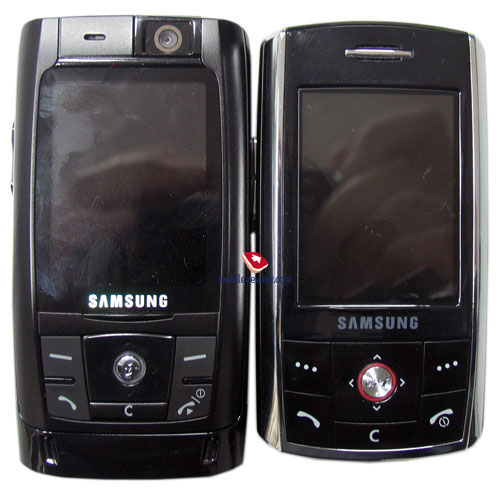
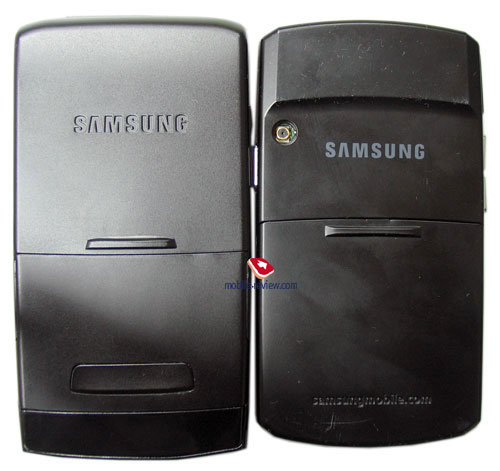
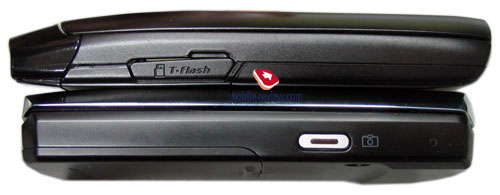
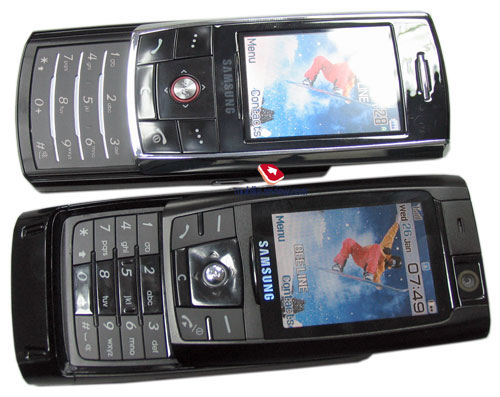

Both models have a coupled key of volume control, charger's and headset's socket covered with a plastic cap on the left lateral face. In these phones the new type of a socket is applied; the company starts changing to it (the first model with this socket is Samsung E910/Serene).
On the right lateral face there is a button of a camera (only D800), slot for MicroSD cards, they are TransFlash as well (only D820). In the senior model you may see vertical slashes at the bottom part of the obverse panel - these are stereo dynamics. Due to the low capacity any changes in the sound's volume or quality in comparison with D800 were not noticed.

Let's turn to the devices size paying attention to the word "thin". From the moment of Motorola RAZR appearance other manufacturers of phones were seized by the mania, every company are trying to present "thin" products, the company Samsung did not become exception. In most cases small thickness is reached exclusively by the increased height and width of the device, the same situation is in our case. The model D800 has the size of 97х52х16 mm in a closed condition that is quite comparable with modern monoblocks (including thickness, the difference is only 2 millimeters). Certainly, there is aesthetics of smaller thickness but the device is not so "thin" as it is presented by the manufacturer. For example the model Samsung P300 has a thickness of the metal case of only 8.9 mm; this is really "thin" solution. One more example is Nokia 8800 which has the thickness of 16.5 mm, but the manufacturer has never even tried to position the phone as "thin". An explanation is that the model is well positioned in its segment even without such additional shifts. So, everything that refers to "thin" models may not be of this kind.
For Samsung D820 the dimensions are a little bit changed, the device is 4 mm higher and a little bit thinner (101х52х14.9 mm). In opened condition D800 has the height of 129 mm, and D820 133 mm (the same difference of 4 mm is kept). D800 weights 98 grams and D820 - 103 grams.
In both models the mechanism of automatic refining when opening and closing the phone is stipulated. It works not so good as at the first sliders by Samsung, other proportions of models have an effect. In D800 you should make the effort to open or close the device, you feel the movement; smoothness of a course is absent (when it is called "like clockwork"). But as a whole the device is quite comfortable and you will get used quickly for these circumstances.
In the D820 the mechanism of automatic refining is much worse. The first impression was that it is absent or broken. But other samples check has shown that there is similar problem with them. The main trouble appears when opening the device, movement is slow with appreciable effort, parts do not slide. The emphasis made under the screen does not help during the opening, the finger slides off it.
At closing it is useless too; if you use it you will have to spend many forces on closing. It is easier to put a finger on the screen and then the movement will be more simple (the same at opening). Traditionally it is possible to use sliders in the closed condition so may answer calls to read messages or move through the menu.
Soft keys accessible in the closed condition are quite comfortable, but an arrangement of the button C under the navi button confuses, it is placed closely. Working with D800 casual pressing C is improbable due the large navi button, and at D820 it is usual. As especially buttons are relief here and the finger moves on C rather often.
Keypad of the D800. Keys are made according to an old technology widely known by thin calculators of the first generation (many people remember such plates at the end of 1980th). The analogy to thin calculators is interesting because the minimal thickness of the case (1.5 mm) was already achieved at that time, the calculator could be hidden though in a wallet or in a pocket. But such calculators have not got accustomed widely; today full-size calculators with the big and convenient keys are still preferable. Probably, the phones miniaturization will go in the same way, some models are not convenient though the look brightly.
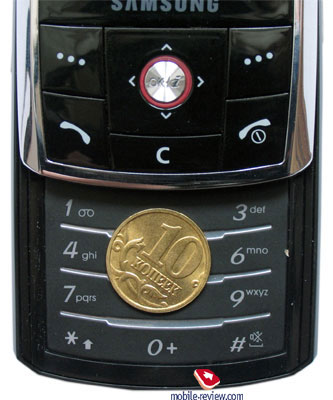

Let's return to the keypad of the D800, one plate is used for all buttons here, contacts are located under it. It is necessary to press through a plate to make the device processed pressing. There is no any key depression, you press a flat surface. The situation is aggravated by the fact that if you have large hands you should press only with finger-end or nail (in the last case the probability to damage the keypad grows in direct ratio to an acuteness of nails and their size). For the top horizontal line of buttons only this type of work is possible, an adjoining part of the case has an effect here. It is possible to characterize the keypad of D800 as extremely inconvenient, during one month of using the device no one person found such solution to be comfortable. Remember by the way, what buttons were used in thin calculators of the second generation, they were the same, but buttons were raised, contact was above (there was a key depression, that made the work more comfortable).
The keypad's backlight is of white color and it is not so bright, but is well visible in full darkness. It is quite comfortable.
Keypad of the D820. Buttons are made of usual plastic; they are of average size but with a light key depression. Its comfort is higher than D800, but it concedes to usual devices or Samsung D600. Due to the stereo dynamics there is a ledge at the bottom part of the case; it is not very pleasant to work with the bottom line of buttons, you will touch an edge of the device. At the same time the top line does not cause any problems. Backlight is also of white color; it is brighter and is well visible in various conditions

Camera's fastening. Both models have the CMOS-module with identical characteristics. In the D800 it is located on the back side of the top part; for taking pictures it is necessary to open the device. It is necessary to note a small mirror and presence of a separate microphone for sound record (only in a video mode). In D820 the separate microphone is not present, but the module is made rotary, that allows establishing two positions (to and from you). There is no big sense in such design, if only you do not photograph yourselves constantly. The camera is not fixed in intermediate positions (for example at an end face), that makes the rotary mechanism senseless (for example in a mode "from you" it is still required to open the device to take pictures).


The display. Models are equipped with the same screen, its characteristics are similar to all today's top models, these are QVGA-resolution of 240х320 pixels (33х44 mm), a diagonal of 2.2 inches. It displays up to 262000 colors. The screen is the own development and is rather good by its characteristics. A picture is juicy, alive and very bright. Comparing screens at identical settings, you will notice that in D800 the display is little bit brighter, but the picture is less sated and fades on the sun more easy. The difference is not too big, but it is present.

The second difference which follows from the distinctions of the software platform is the menu and inputting font size. In D800 the size of inscriptions is much higher, that makes them better readable. At the same time the same number of lines is always visible on the screen, there is no difference.
Battery. The model uses the standard Li-Ion battery having capacity of 800 mAh; the battery of the higher capacity is not provided. According to the manufacturer it works for 180 hours in the standby mode and up to 3 hours in the talk mode. In Moscow the devices worked for about 2 days in case of 1 hour of talks and 20 minutes of other functions use. The maximum operating time is 3 days in case of few talks. Full recharging takes about 1 hour and 30 minutes. It is rather problematic to open the cap covering the battery; the device starts to disclose, it is necessary to apply forces.

Menu
The difference in the menu is only the icons' appearance. Two types of presenting are supported - Block (ordinary icons matrix) and Flash (when one of the points is marked with large icon). Shortcut number navigation is available. The entire submenu is presented in lists; in the second level, it is possible to move in between the lists by means of horizontal titling. Special functions selected from the list can be assigned to the scroll key. Overall, the menu arrangement is rather convenient and there are no problems with the navigation.
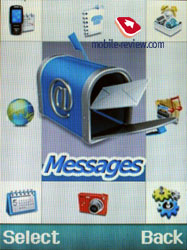

Phonebook. By pressing the right soft key, one can obtain the contacts in a form of a list containing all the files both from the phone's and the SIM-card memory. The first name in the list is backlit by default and the number is shown in the status bar (there is a special sign for numbers from a SIM-card). There is a fast search by first letters of a name; the phone can hold more than twenty of those for any possible language. By pressing the OK key, you enter in the view menu of a single file where you may see a small icon in case the name is matched with the image. Any graphic file or the pictures of your own may be used as such image. Up to five phone numbers of various types (cell, office, home, fax, other) may be kept for a name with one number as the main contact (it would become the first one by default). The fields are strictly fixed and there may be not two cell phone numbers entered. On the other hand, SMS/MMS can be sent to any number from the phone book once chosen.

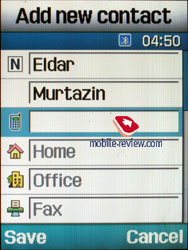


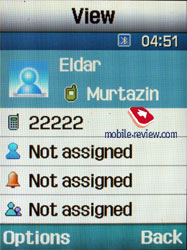
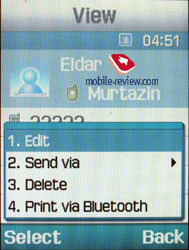
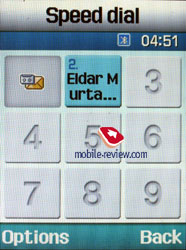
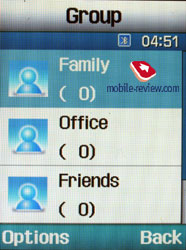
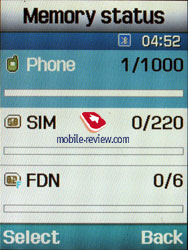
There are two fields for a Name and a Surname (search only by the first one) that are concatenated when displayed and the Name field goes the first. For example, if you entered Eldar Murtazin, it is displayed exactly in this manner. The length of each line is 20 symbols for any of the available languages. You may opt to alter the language while inserting the text as well.
Files in different languages are sorted out according to a rule - first it will be all files in the local language (Russian, for example), and then those in English. This is rather convenient and habit forming. Taking into account an option of fast language change during the search, it becomes clear that the files in different languages do not impede the work with this phone.
Let us return to the information entered for one name. Besides phone numbers, an e-mail address and a little text memo can be recorded. Any music file as well as composed MP3's can be chosen as a ring tone for the name. Three caller groups are preinstalled and out of any category. You can easily create a necessary number of groups, select a personal melody and image for each. D800 does not have any preinstalled groups but all settings are the same.
Up to 1000 names with all the data can be saved in the phone's memory. Even if all the available lines are not used, the number of names to be saved would remain a thousand. It is possible to indicate in the settings where the new numbers should be kept by default. There is an option of moving files from the SIM-card although not vice versa. According to the developers, PC is the best means of synchronization, MS Outlook in particular. Any file in the form of SMS/MMS, mail message or other text file can be sent quickly through Bluetooth to another device. There are no problems with sending and the phone book entry being transmitted to another device is precisely decoded without any trouble.
New names can be entered only through the main menu; the right soft key always calls for the name list only. You can create your own visit card; its format would be the one of a regular file from the phone book.
There can be up to eight numbers in the speed dial list; peculiar is the fact that separate numbers of one name may be in this list as well. The subtitle of the chosen name (but not of the phone type) is displayed on the buttons.
When receiving a call, a picture is displayed not on the full screen, but on a part of it, nevertheless having rather large size.
Call lists. Up to twenty phone numbers are displayed in each list. There is a combined list of all the last calls with an icon indicating a call type. Tilting the scroll key horizontally, you may switch quickly from one list to another. The date and the time of the call (it's duration is not kept) can be seen for separate files. Similar calls are summed; amount of calls is shown at the opposite from the number. In the detailed view you may see the time of each call. As always, the overall time of the calls and their prices can be viewed in this menu (this service has to be installed).

Messages. Working with different types of messages is done through separate submenus. Let us begin with short messages. Up to 200 messages can be saved in the phone's memory; the phone supports the EMS standard compatible with Nokia Smart Messaging. T9 functions very well.
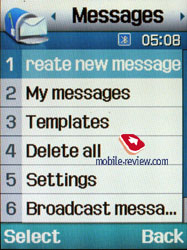
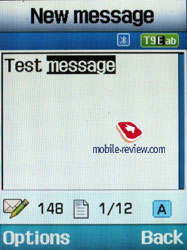

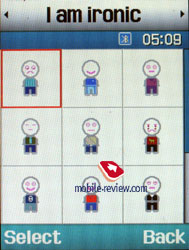

MMS. The interface for multimedia messages is very nice; the messages can be saved in several folders at once and right away. There are no size restrictions for a message to be received although a message should not exceed 295 KB. As for additional services, the rejection of advertising messages, the option of the message receipt in the roaming and the home network should be mentioned. The messages are saved in the general memory since there is no special memory for them.
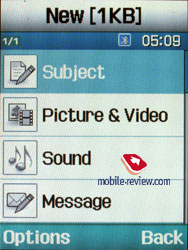
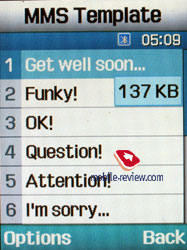
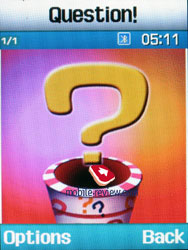

Organizer. Up to 400 events of four types - meeting, affair, anniversary and others, can be saved in the phone's memory. The day and the time as well as its end are indicated for each file. A signal can be set for the interval during which it has to go off; repetitive events are available for setting. The weekly and the monthly calendar are very convenient with each type of the event having its own color.
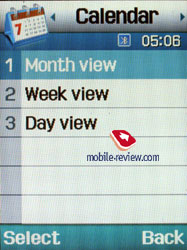


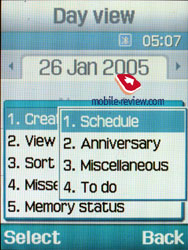
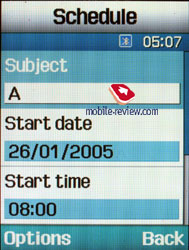
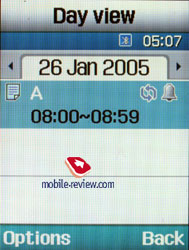
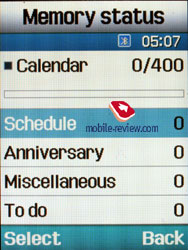
WAP. There is a wap-browser version 2.0 similar to some phones by Nokia and Sony Ericsson using http protocol. That means in some networks operator's setting is required. It is imposible to set the time of the timeout in D 820, that will become a problem for many people (connection's break by timeout).

Applications. MP3 player. An integrated mp3 player supporting accidental track reproduction, both sequential and cyclic, is available in the phone. Mp3 files can be downloaded into the phone both directly through Bluetooth and through a synchronization program. Files may be of various names and tags (in Russian language as well!). The bit rate of the files is not that important since the phone accepts all the possible formats.
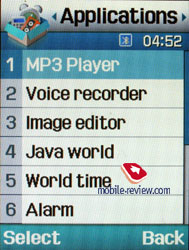
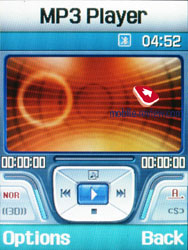
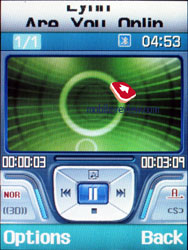

Among some special features sound transfer by Bluetooth to the stereo headphones can be mentioned. This profile appeared in last models by Samsung.
The name of the track playing is displayed as well as the overall number of different composition. An equalizer is of an entertaining nature; there are no separate settings. The tracks can be played through the stereo headset as well as through the speakerphone. The volume has ten levels. The user is welcome to create play lists of his/her own. Up to 76 Mb in D800 or flash card and internal memory in D820 can be used for mp3 melodies. Player works in a background mode only at D800; we do not see this option in D820.
Dictaphone. You can record up to several hours of voice memos with the number of files being unlimited. The time restrictions for one recording are set by a user and can be one hour in duration. All the files are kept in a separate folder in the memory. The recorder can function well during lectures, conferences and presentations. The phone is a partial substitute for a digital tape recorder.
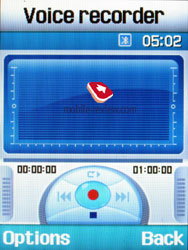

Java World. Up to four MB of memory are available in the phone for various programs. This is a separate memory allotment and is used for Java only. MIDP 2.0 version allows the use of the graphic reach and three-dimensional games. There are three preinstalled games in D820 - Forgotten Warrior, Arch Angel, Freekick. Only two games are preinstalled foe D800 - Bobby Carrot, Time Rider II.
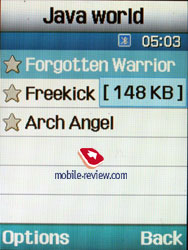
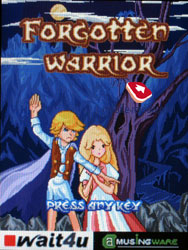
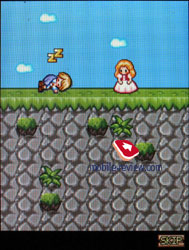
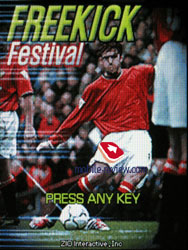
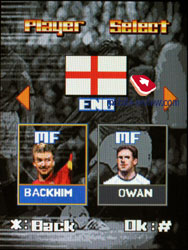

World time is displayed for two chosen cities. Everything is nice and simple here.
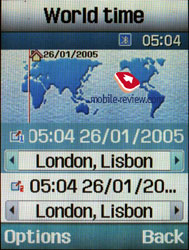
Alarm clock. The phone is equipped with three alarm clocks. One is meant for mornings and can be set for selected weekdays, however, that is typical of the two others also. For each of the alarm clocks there is a selection of five melodies but also mp3 compositions can be used here. It is up to a user to indicate in the settings whether the phone would turn on automatically in the time of the event or not.


Calculator. Everything is nice and simple here.

With a Сonverter, you can operate with different units of measurements as well as with the currencies.
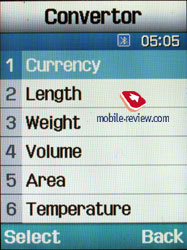
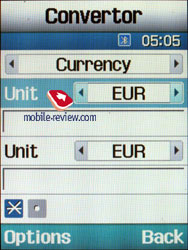
Countdown timer. The time can be displayed in both hours and minutes; the clock can be used as a background.

You can request the intermediate result with a stopwatch.

Pictures Editor. It is a simple editor which helps you to make some simple pictures transformation and putting effects.
Voice commands (only D800). A system of voice recognition independent of the pronunciation is integrated into the device. It allows both dialing a number from the phonebook and navigation in the menu. Samsung E620 was the first to provide the feature; the function was not applied in local versions of the device. The recognition works with no problems, the system got more stable in exterior conditions, especially at significant noise.
Funbox. All the files, such as music, images, videos and sounds are kept here. All the downloaded files are also stored here. One disadvantage here is that sometimes the file is not immediately displayed in the general list and a user has to exit and open the list again.
Settings. That is traditional that you are allowed to choose font colour in the standby mode, protect any section of the phone with a password (messages, short messages, organizer and so on). You may set the time for backlighting on and its brightness.

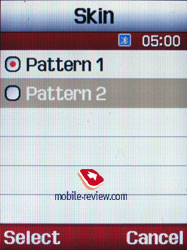
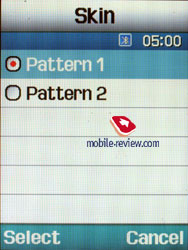
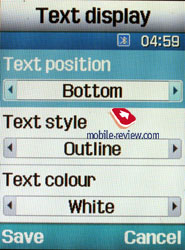
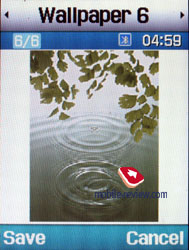
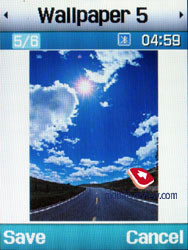
Bluetooth. The model supports various profiles like Headset, Handsfree, Serial Port, Dial Up Networking, File Transfer, Object Push, A/V Headset, Basic Printing (version Bluetooth 1.2). Bluetooth works not ideally, sometimes problems with phones having only Headset profile happen, sometimes work with a speakerphone can be incorrect. Bluetooth is realized averagely on the level of Nokia, however losing to Sony Ericsson.
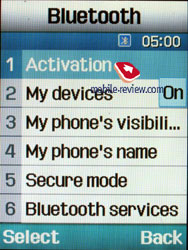

Camera. The module of the camera is 1,3-MP and is almost similar to other models by Samsung. The camera is usual and lets receiving pictures of good quality and to display them at the TV screen. St the same time some pictures are not so good when viewing at the PC.
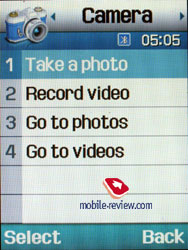



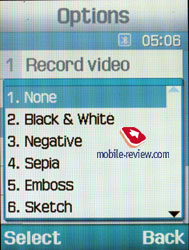

The camera works in 6 different resolutions:
- SXGA (1280x1024)
- Мега (1152x864)
- VGA (640x480)
- QVGA (320x240)
- QCIF (176x144)
- Sub- QCIF (128 x 96)
The compression quality for JPEG pictures is set separately, several types are available:
There are about 5 different sounds for a shutter and the sound may be turned off at all then taking photos won't draw everybody's attention. A default file name, the sensitivity of the matrix (Auto, ISO 100, ISO 200, ISO 400) may be set. I'd recommend using an Auto mode because it works correctly mostly. The difference between sensitivity modes is not felt in usual conditions. You won't see any changes on a real photo.
The timer for selfshooting is set for 3, 5 or 10 seconds.
The matrix mode switches the camera to the lowest resolution (a final picture is 640 x 480 pixels) and you get a picture that consists of 4 or 9 items (2x2 or 3x3). It's a curious mode that may be interesting for experiments.
In a multishooting mode it's possible to select some series, in particular that may be 6 photos with high speed (practically immediate pictures), with normal speed (the period between the photos is a second or less). Also modes with 9 and 15 photos are available. I'll note that the function is interesting as a photofinish at a competition, in real life if moving the camera the photos will be blurry in the majority of cases. The resolution is 320x240 in this mode.
Switching into a shooting mode is done either by pressing a side button or via the menu. The screen of the phone serves as a viewfinder, using a navi button you may change the contrast level and use zoom. When the resolution is maximum, the zoom function is turned off automatically. The picture may be mirrored on the screen using side buttons.
Samsung D800/D820
|
 |
 |
(+)
increase, 1280x1024, JPEG |
(+)
increase, 1280x1024, JPEG |
 |
 |
(+)
increase, 1280x1024, JPEG |
(+)
increase, 1280x1024, JPEG |
 |
 |
(+)
increase, 1280x1024, JPEG |
(+)
increase, 1280x1024, JPEG |
 |
 |
(+)
increase, 1280x1024, JPEG |
(+)
increase, 1280x1024, JPEG |
 |
 |
(+)
increase, 1280x1024, JPEG |
(+)
increase, 1280x1024, JPEG |
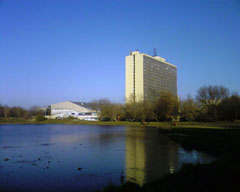 |
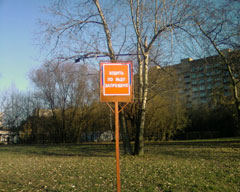 |
(+)
increase, 1280x1024, JPEG |
(+)
increase, 1280x1024, JPEG |
There is a number of effects in the phone that may be applied either during a shooting process or while postediting. As for me, the second variant is more acceptable just like applying frames to the photos. We'll just name the effects and you may get acquainted with them in a separate archive (Black & White, Negative, Sepia, Emboss, Sketch, Orange, Aqua, Red focus, Yellow focus, Blue focus). The last three effects distinguish the main colors of the composition but the function is middling in the majority of cases.
The photos are kept in an album and here you may view the data on a certain photo (not above the photo as in previous models). The list is formed fast and indicates the phone name and a small icon. Any photo may be assigned to a name in the phone book or set as a wallpaper just from the album menu. There is a slide show mode, a plain editor that allows adding emotion icons, apply frames and effects to the photos.
The phone records 3GP video and you may choose recording with sound or without it. All the settings are comparable with similar for photos, the same 3 quality levels but the resolutions are different. The minimal resolution is 355х288 pixels, both models are the best at the market by their video opportunities.
There is no any limit on the duration of the record and everything depends on the free memory. Specially for MMS a recording mode that doesn't allow to exceed 100 KB is provided.
Video sample (1.71 MB)
Synchronization with PC. Synchronization using a cable or bluetooth is supported. You may download the special software Easy Studio 3.0 for these goals from the company's web site.
Memory card in D820. A TransFlash slot card allows keeping any types of files and working with them using the appropriate files manager. Each menu contains the item "memory card". It is active when the card is in the slot, when it is not there the item is inaccessible. From fine defects it is necessary to note that memory cards are unusual for the company and the interface and the maximal integration of memory cards in existing opportunities of the device is not developed up to the end.
So, there is no opportunity to create mixed playlists that would unite files from memory card and internal memory. For the memory card the rigid folders structure which is similar to the phone's memory structure was initially created. That means, that the phone will not see files which are contained in other folders, it will ignore them. Subdirectories in standard folders are supported. Files can be copied or transferred between two types of memory using standard ways. It is not impossible to select all files at once (you should select them one by one) that is rather inconvenient when having a lot of files. The memory card is necessary first of all for music and images storing; it copes well with this task.
Picsel Viewer. The presence of Picsel Viewer is one of the main strengths of the models D800/D820. To describe shortly, Picsel Viewer is an application that is capable of opening MS Office files (for instance, MS Word, Excel, PowerPoint), Adobe Acrobat (PDF), graphical and video formats on the phone. All the pressure of the technology is its fast action, opening a 20 MB PDF file will take about a couple of seconds, then you can quickly scroll pages, scale them, rotate. No editing capabilities, only viewing, but that is enough sometimes, especially considering there is no need in extra converting for the mobile phone.
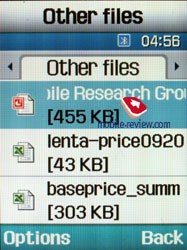
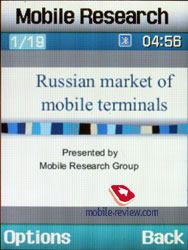

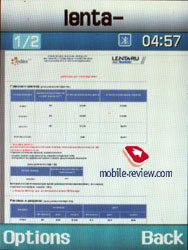

Besides viewing data on the screen, an image may be sent to external sources, for instance, a TV-set, projector. A TV-OUT cable is included into the kit. One end of the cable is miniUSB and another one is three "tulips" for connecting to external sources. I had a TV-set as an external source. Put all the cables in and connect to the phone. And here it is! The menu is shown on the TV screen, moving along the phone menu you see your actions on the screen. Besides Picsel Viewer documents, you can view any standard applications, full-screen video (pixels are seen too much for 3GP files, the resolution is still improper), photos, play games if you like to. A TV-set not only represents the picture but reproduces the sound from the phone.
Productivity. The results of all three Jbenchmark test kits did not cause any surprises, productivity of both models is comparable with other devices by Samsung. These are average values, there are no any serious problems, but at the same time these devices are not champions by their speed of operating. D820 does not support JSR-184, that means that three-dimensional games cannot be run here.
|
D600 |
D800 |
| JBenchmark 1 |
1389 |
1040 |
Details |
| Text |
350 |
315 |
| 2D Shapes |
353 |
263 |
| 3D Shapes |
230 |
169 |
| Fill Rate |
179 |
95 |
| Animation |
277 |
198 |
1.1.1 |
|
D600 |
D800 |
| Jbenchmark 2 |
132 |
87 |
Details |
| Image manipulation |
76 |
69 |
| Text |
167 |
109 |
| Sprites |
124 |
86 |
| 3d Transform |
133 |
86 |
| User Interface |
188 |
86 |
2.1.1 |
|
|
D800 |
| Jbenchmark 3D
|
Details |
| Jbenchmark3D HQ: |
59 |
| Jbenchmark3D LQ: |
84 |
| Triangles ps: |
7181 |
| kTexes ps: |
320 |
3.1.0 |
Impressions
Connection quality of models have no any censures, it is typical for modern phones. The sound in the dynamics is pure; there is no any extraneous noise. The volume of 64- polyphony is average, and the volume of mр3 melodies is sufficient to hear the device on a bustling street. The vibrating alert is of an average force.
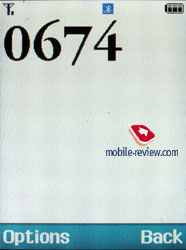
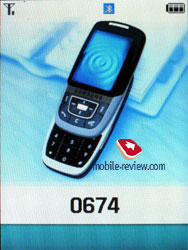

Both models do not support SWF-files. There is an indication of EDGE mode, GPRS's icon becomes red. This option works without any censures.
Creation of models based on various hardware platforms should have an effect. On the side of the D800 there is an opportunity of playing mр3 files in a background mode, the presence of voice dialing and commands, better realization of wap-browser, presence of separate settings of keypad's work, its backlight (in the specified time intervals). At the same time the D820 offers more comfortable keypad and slot for MicroSD cards. The design of the senior model is simpler, D800 is brighter. It was initially declared that Picsel Viewer and TV-Out are only in D820, but later this function has appeared everywhere. The D800's standard kit does not include the appropriate cable and that is all.
The beginning of Samsung D800 shipments to the market is planned to the end of December; its price will make 450-500 dollars. The model D820 will appear at the end of January and will cost about 550-600 dollars. Both solutions are extremely fashion though they have quite decent functionality. Phones concede by their comfort to a number of models, mostly because of the keypad. A weak place for both models is the dynamic, at the maximal volume it can leave out of operation (it depends on the type of mр3 ring used and of its frequencies). It is not desirable to experiment with the menu of the latent dynamic's settings, because it is possible to destroy the basic dynamic.
In some measure the given models are just the test models, they will not become major for the company. At the end of summer a model based on the D800, in a metal case, with less thickness, 2-MP camera and also equipped with memory cards will appear. This product should become fashion. While Samsung D800/D820 will promote due to advertising. Taking into account, that the company is the leader by sales in sliders segment, it is possible to predict successful destiny for these models as well.
Eldar Murtazin (eldar@mobile-review.com)
Translated by Yana Vilchek(maria.mitina@mobile-review.com)
Published — 15 December 2005
Have something to add?! Write us... eldar@mobile-review.com
|






































































































